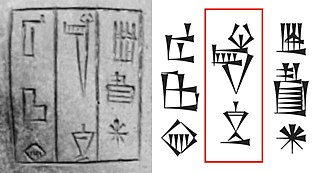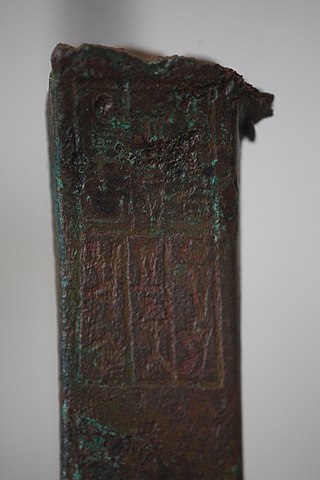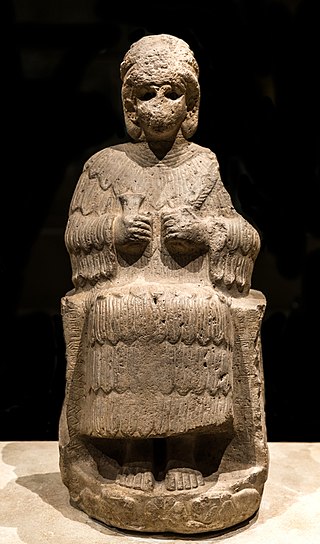Related Research Articles

Elam was an ancient civilization centered in the far west and southwest of modern-day Iran, stretching from the lowlands of what is now Khuzestan and Ilam Province as well as a small part of southern Iraq. The modern name Elam stems from the Sumerian transliteration elam(a), along with the later Akkadian elamtu, and the Elamite haltamti. Elamite states were among the leading political forces of the Ancient Near East. In classical literature, Elam was also known as Susiana, a name derived from its capital Susa.

Pinikir, also known as Pinigir, Pirengir, Pirinkir, and Parakaras, was an Ancient Near Eastern astral goddess who originates in Elamite religious beliefs. While she is only infrequently attested in Elamite documents, she achieved a degree of prominence in Hurrian religion. Due to her presence in pantheons of many parts of the Ancient Near East, from Anatolia to Iran, modern researchers refer to her as a "cosmopolitan deity."
Nahhunte was the Elamite sun god. While the evidence for the existence of temples dedicated to him and regular offerings is sparse, he is commonly attested in theophoric names, including these of members of Elamite royal families.

Inshushinak was the tutelary god of the city of Susa in Elam. His name has a Sumerian etymology, and can be translated as "lord of Susa". He was associated with kingship, and as a result appears in the names and epithets of multiple Elamite rulers. In Susa he was the main god of the local pantheon, though his status in other parts of Elam might have been different. He was also connected with justice and the underworld. His iconography is uncertain, though it is possible snakes were his symbolic animals. Two Mesopotamian deities incorporated into Elamite tradition, Lagamal and Ishmekarab, were regarded as his assistants. He was chiefly worshiped in Susa, where multiple temples dedicated to him existed. Attestations from other Elamite cities are less common. He is also attested in Mesopotamian sources, where he could be recognized as an underworld deity or as an equivalent of Ninurta. He plays a role in the so-called Susa Funerary Texts, which despite being found in Susa were written in Akkadian and might contain instructions for the dead arriving in the underworld.

Puzur-Inshushinak, also sometimes thought to read Kutik-Inshushinak in Elamite, was king of Elam, around 2100 BC, and the last from the Awan dynasty according to the Susa kinglist. He mentions his father's name as Šimpi-išhuk, which, being an Elamite name, suggests that Puzur-Inshuhinak himself was Elamite.
Haft Tepe is an archaeological site situated in the Khuzestan Province in south-western Iran, about 15 kilometers southwest of the ancient city of Susa. At this site the possible remains of the Elamite city of Kabnak were discovered in 1908, and excavations are still carried out.

Kiririsha was a major goddess worshiped in Elam.
Humban-Numena was a king of Elam from the Igihalkid dynasty. He was a son and successor of King Attar-kittah. He married a daughter of the Kassite king Kurigalzu, who bore him Untash-Napirisha, who was thus a grandson of Kurigalzu. According to another interpretation of the primary source, he married the daughter of his uncle Pahir-ishshan, himself the son of a Kassite princess, and was thus a great-grandson of Kurigalzu.

Shakkanakku, was an Akkadian-language title designating a military governor. Mari was ruled by a dynasty of hereditary Shakkanakkus which was originally set by the Akkadian Empire and gained independence following Akkad's collapse. It is considered that the Shakkanakkus gained some form of independence and came to be considered as "Kings" from the time of Apil-Kin. A critical analysis of the Shakkanakku List of Mari has been published.
Napirisha was a major Elamite deity. He likely originated from Anshan.

The Sukkalmah or Epartid dynasty, was an early dynasty of West Asia in the ancient region of Elam, to the southeast of Babylonia. It corresponds to the third Paleo-Elamite period. The Sukkalmah dynasty followed the Shimashki dynasty. The title of Sukkalmah means "Grand Regent" and was used by some Elamite rulers. Numerous cuneiform documents and inscriptions remain from this period, particularly from the area of Susa, making the Sukkalmah period one of the best documented in Elamite history.

Ili-ishmani was a ruler of Elam around 2200 BCE. His name is purely Akkadian, and he was in charge of Elam at the time of Naram-Sin and/or Shar-Kali-Sharri, and probably their vassal. His title of "Military Governor" suggests that he was a dependent of the Akkadian kings, rather than an independent ruler. Ili-ishmani rose from the position of scribe, already one of the top three positions in the land, to the position of Governor.

Narundi or Narunde was an Elamite goddess worshiped in Susa. She is attested there roughly between 2250 BCE and 1800 BCE. Multiple inscriptions mention her, and it assumed she was a popular deity at the time. In later periods, she occurs exclusively in Mesopotamia, where she played a role in apotropaic rituals in association with the Sebitti. Many attestations are available from late Assyrian sources, but it is not certain if they should be regarded as an indication of continuous worship.
Manzat (Manzât), also spelled Mazzi'at, Manzi'at and Mazzêt, sometimes known by the Sumerian name Tiranna (dTIR.AN.NA) was a Mesopotamian and Elamite goddess representing the rainbow. She was also believed to be responsible for the prosperity of cities.
Lagamal or Lagamar was a Mesopotamian deity associated chiefly with Dilbat. A female form of Lagamal was worshiped in Terqa on the Euphrates in Upper Mesopotamia. The male Lagamal was also at some point introduced to the pantheon of Susa in Elam.

The Shutrukid dynasty was a dynasty of the Elamite empire, in modern Iran. Under the Shutrukids, Elam reached a height in power.
Ishmekarab (Išmekarab) or Ishnikarab (Išnikarab) was a Mesopotamian deity of justice. The name is commonly translated from Akkadian as "he heard the prayer," but Ishmekarab's gender is uncertain and opinions of researchers on whether the deity was male or female vary.

Indattu-Inshushinak II, often referred to by the shortened name Indattu or Idaddu II, was the tenth king of Elam who came from the dynasty of Shimashki, a city of unknown location.

Hutelutush-Inshushinak, son of Shilhak-Inshushinak I, was an Elamite king belonging to the Shutrukid dynasty, ruling c. 1120-1100 BC. During the reign of Hutelutush-Inshushinak, Elam was heavily raided by king Nabu-kudurri-usur I of Babylon's Second Dynasty of Isin.
References
- ↑ Basello, Gian Pietro; Alvarez-Mon, Javier; Wicks, Yasmina (2018). The Elamite World. Taylor & Francis. ISBN 9781317329831.
- 1 2 Potts, Daniel T. (1999). The Archaeology of Elam: Formation and Transformation of an Ancient Iranian State. Cambridge University Press. p. 192. ISBN 9780521564960.
- ↑ Alvarez-Mon, Javier (2020). The Art of Elam ca. 4200 - 525 BC. Taylor & Francis. ISBN 9780521564960.